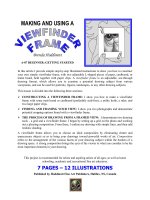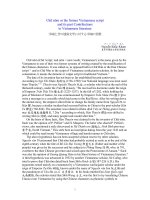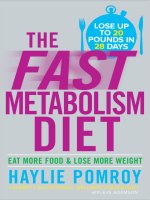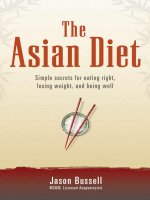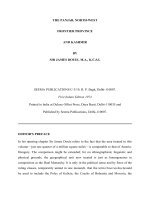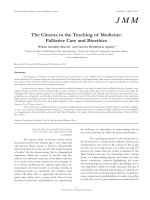The Fast Food Diet Lose Weight and Feel Great Even If You’re Too Busy to Eat Right ppt
Bạn đang xem bản rút gọn của tài liệu. Xem và tải ngay bản đầy đủ của tài liệu tại đây (927.86 KB, 258 trang )
The
F
ast
F
oo
d
D
iet
Lose Weight and Feel Great Even If
You’re Too Busy to Eat Right
STEPHEN SINATRA, M.D.,
and
JIM PUNKRE
Foreword by Barry Sears, Ph.D.
John Wiley & Sons, Inc.
ffirs.qxp 6/28/06 3:20 PM Page iii
ffirs.qxp 6/28/06 3:20 PM Page ii
The
F
ast
F
oo
d
D
iet
ffirs.qxp 6/28/06 3:20 PM Page i
ffirs.qxp 6/28/06 3:20 PM Page ii
The
F
ast
F
oo
d
D
iet
Lose Weight and Feel Great Even If
You’re Too Busy to Eat Right
STEPHEN SINATRA, M.D.,
and
JIM PUNKRE
Foreword by Barry Sears, Ph.D.
John Wiley & Sons, Inc.
ffirs.qxp 6/28/06 3:20 PM Page iii
Copyright © 2006 by Stephen Sinatra, M.D., and Jim Punkre. All rights reserved
Published by John Wiley & Sons, Inc., Hoboken, New Jersey
Published simultaneously in Canada
Design and composiiton by Navta Associates, Inc.
Designations used by companies to distinguish their products are often claimed as trade-
marks. In all instances where John Wiley & Sons, Inc., is aware of a claim, the product
names appear in initial capital or all capital letters. Readers, however, should contact
the appropriate companies for more complete information regarding trademarks and
registration.
No part of this publication may be reproduced, stored in a retrieval system, or transmitted
in any form or by any means, electronic, mechanical, photocopying, recording, scanning,
or otherwise, except as permitted under Section 107 or 108 of the 1976 United States
Copyright Act, without either the prior written permission of the Publisher, or authoriza-
tion through payment of the appropriate per-copy fee to the Copyright Clearance Center,
222 Rosewood Drive, Danvers, MA 01923, (978) 750-8400, fax (978) 646-8600, or on
the web at www.copyright.com. Requests to the Publisher for permission should be
addressed to the Permissions Department, John Wiley & Sons, Inc., 111 River Street,
Hoboken, NJ 07030, (201) 748-6011, fax (201) 748-6008, or online at ey
.com/go/permissions.
The information contained in this book is not intended to serve as a replacement for pro-
fessional medical advice. Any use of the information in this book is at the reader’s discre-
tion. The author and the publisher specifically disclaim any and all liability arising directly
or indirectly from the use or application of any information contained in this book. A
health care professional should be consulted regarding your specific situation.
For general information about our other products and services, please contact our
Customer Care Department within the United States at (800) 762-2974, outside the
United States at (317) 572-3993 or fax (317) 572-4002.
Wiley also publishes its books in a variety of electronic formats. Some content that
appears in print may not be available in electronic books. For more information about
Wiley products, visit our web site at www.wiley.com.
Library of Congress Cataloging-in-Publication Data:
Sinatra, Stephen T., date.
The fast food diet : lose weight and feel great even if you’re too busy to eat right /
Stephen Sinatra and James Punkre ; foreword by Barry Sears.
p. cm.
Includes bibliographical references and index.
ISBN 0-471-79047-8 (pbk.)
1. Reducing diets—United States. 2. Weight loss—United States. 3. Convenience
foods—Health aspects—United States. 4. Fast food restaurants—Health aspects—
United States. 5. Food habits—United States. I. Punkre, Jim. II. Title.
RM222.2S555 2006
613.2'5—dc22
2006002082
Printed in the United States of America
10 9 8 7 6 5 4 3 2 1
ffirs.qxp 6/28/06 3:20 PM Page iv
This book is dedicated to the parents of America—and to their
children, who are the hope of our country’s healthy future.
We can end the obesity epidemic that is ruining America.
Children learn by imitating their parents’ actions. No matter
what your socioeconomic-cultural level may be, your children
will follow what you do, not merely what you say. If you set
the example of choosing healthier foods and better nutrition in
general, so will your children. You’ll be giving them a gift that
will last their entire lifetime, so they can enjoy a healthy life
that is free of disease, suffering, prescription drugs, and pre-
mature death.
Stephen Sinatra, M.D.
Jim Punkre
ffirs.qxp 6/28/06 3:20 PM Page v
ffirs.qxp 6/28/06 3:20 PM Page vi
Acknowledgments ix
Foreword by Barry Sears, Ph.D. xi
Introduction
Get Smarter, Get Slimmer on Fast Food 1
1
The 80/20 Rule 9
2
Why Regular Diets Fail 15
3
The Secrets of Easy Weight-Loss Success 31
4
The Fast-Food Diet Restaurant-by-Restaurant
Guide 47
5
Smart Sit-Down Dining 71
6
The Fast-Food Diet at the Mall 95
7
The Six-Week Fast-Food Diet 105
8
Fast Food at Home 125
9
The Fast-Food Diet for Kids 151
10
The Fast-Food Diet Vitamins and Supplements 157
11
The Fast-Food Diet for Business Travelers 179
12
The Fast-Food Diet for the Holidays 187
vii
CONTENTS
ftoc.qxp 6/28/06 3:21 PM Page vii
13
The Fast-Food Diet for Vegetarians 191
14
The Fast-Food Diet Walking Plan 195
15
The Future of Fast Food 213
Appendix A
The Glycemic Foods Index 221
Appendix B
Low-Calorie Snacks 223
Bibliography 225
Index 229
viii CONTENTS
ftoc.qxp 6/28/06 3:21 PM Page viii
To Jim Punkre, who gave me the idea for this book as well as
his insightful ideas and tireless energy that helped make the
book a reality.
To Matthew Hoffman for his research into the fast-food
industry, Martina Punkre for her detailed editing, Debbie Del-
Signore for keeping all the details straight, and Jeff Cox for his
eagle eye.
To Tom Miller, our editor at John Wiley & Sons, for giving
us the opportunity to help improve the way America eats.
To Bob Tuttle, who gave me the chance to manage his fast-
food restaurant in Bellmore, New York, back in my high
school years.
To my editorial, research, and marketing team for my
monthly newsletter Heart, Health & Nutrition published by
Healthy Directions in Potomac, Maryland.
To JoAnne Piazza, my trusted assistant and advisor.
To my sibs who grew up with me in Long Island: Pam,
Dick, and Maria; and to their wonderful second families.
To all our children and grandchildren: Donna, Dan, Kristin,
Brad, Greg, Jen, March, Step, Drew, Emma, Claire, Cecelia,
and Cal.
ACKNOWLEDGMENTS
ix
flast.qxp 6/28/06 3:22 PM Page ix
To Jan Sinatra, my wife, best friend, late-night editor, lover,
and life companion.
—Stephen Sinatra, M.D.
Jim Punkre
x THE FAST FOOD DIET
flast.qxp 6/28/06 3:22 PM Page x
The fast-food industry today is facing a tremendous challenge
as well as an unprecedented opportunity. Fast food has been
instrumental in conquering the problem of hunger in America.
A warm meal is now so affordable and abundantly available
that no one in our country should ever have to go hungry. The
challenge the fast-food industry now faces is to make their
meals more nutritious and calorie-conscious to benefit the
health and weight of their customers.
We are eating more fast food in North America than ever
before, and experts say this trend will not only continue but
increase. Time and money constraints will force this upon us.
Soon the lovingly prepared home-cooked meal of yesteryear
will become the rare luxury that today’s four-star restaurant
experience now is. Faced with rising levels of obesity and diet-
related health problems, the fast-food industry must accept the
responsibility of providing more healthful and less fattening
items on their menus. Their customers deserve a real choice. It
is no coincidence that people who rely upon fast food for a sig-
nificant portion of their diet are among the 40 percent of Amer-
icans who have inadequate or no health insurance. This
unfortunate situation is unlikely to change any time soon, so Dr.
FOREWORD
xi
flast.qxp 6/28/06 3:22 PM Page xi
Sinatra’s solution presented in this book is especially
timely—
and practical.
Dr. Steve Sinatra is one of the top preventive cardiologists
in America. No one has a better understanding of the impor-
tance of food in preventing and reversing cardiovascular disor-
ders and other degenerative diseases. The uniqueness of The
Fast Food Diet is that Dr. Sinatra, instead of condemning the
fast-food industry or pressuring it to change, is initiating this
important transformation at the grassroots level. In The Fast
Food Diet, he shows readers how to eat smarter and more
nutritiously at any fast-food establishment so they will actu-
ally become healthier as they lose weight. What a brilliant
strategy and practical approach!
This book is greatly needed because, while our daily life is
ruled by time compression, our genes still herald from the
Stone Age and rule our dietary desires. We are genetically
conditioned to require small meals every four to six hours; a
seemingly impossible task given today’s lifestyle. Further-
more, our genes dictate a balance of protein, carbohydrate, and
fat to provide the best hormonal response for weight control
and overall wellness.
This is where fast food comes in. With a little know-how, you
can always find protein in any fast-food restaurant. To maintain
a healthy weight, you simply need to reduce the carbohydrates
and sugars that accompany it to keep your appetite and insulin
under control until your next meal. That’s what this book will
teach you. Once you master the simple tricks developed by Dr.
Sinatra, you can indeed make use of fast food as a realistic alter-
native in times when you can’t make the ideal choice.
There is much truth in the saying “You are what you eat.”
Steve Sinatra demonstrates that fast food can actually help you
achieve your ultimate goal of continuing wellness.
—Barry Sears, Ph.D., author of The Zone
xii FOREWORD
flast.qxp 6/28/06 3:22 PM Page xii
A
merica is a fast-food nation, for better and for worse.
Consider the typical weekday. The alarm goes off
and the family’s bare feet start hitting the floor immediately.
Everyone’s probably running a little late because they didn’t
get enough sleep. (Americans sleep an average of seven hours
a night, down from nine hours a century ago.) Getting the kids
ready for school requires a Herculean effort: brushing teeth,
washing faces, and digging under the couch for overdue
library books. Time for a quick bowl of cereal? Probably not.
So you rush out the door with an empty stomach. Maybe
you’ll snatch something on the way—or just do without any-
thing to eat until lunch.
This frenetic pace doesn’t let up at work. There’s hardly
such a thing as a lunch “hour” anymore. More likely you’ll
grab food at a take-out joint near the office and wolf it down
on the way to the bank or some other errand. Then it’s back to
1
INTRODUCTION
Get Smarter, Get Slimmer
on Fast Food
cintro.qxp 6/28/06 3:23 PM Page 1
work until quitting time maybe five, six, or seven hours later.
At that point your blood sugar is crashing and the last thing on
your mind is cooking something from scratch. Ravenous and
stressed-out from your day, you point the car to KFC or
Wendy’s or Burger King. You want something fast because
you’re practically starving and there’s still the kids’ homework
to oversee, chores to do, and perhaps a game or your favorite
TV show to catch before crashing into bed.
Fast food is so affordable and plentiful that millions of
North Americans eat it every single day—or many times a
week. We now eat on average five meals a week outside the
home, in addition to snacking on convenience foods. The aver-
age adult consumes three hamburgers and four orders of fries
every week. On any given day, 25 percent of all people in
North America eat a fast-food meal. It’s just so easy to hop in
the car, zip the whole family through the drive-thru, and have
dinner over and done in ten or fifteen minutes. No cooking, no
cleanup, no stress—with time left over for errands and maybe
some TV, plus change from a twenty-dollar bill.
But there is another side to fast food, a darker side that
many people are now becoming aware of “the hard way,” as we
doctors say. We can no longer deny that all this fast food is
making us fat. It is also making us sick. I’ve been called to the
emergency room in the middle of the night to try to save a
mom or dad who has just suffered a heart attack. I know kids
who are nine, ten, eleven years of age who must inject them-
selves with insulin shots every day because they already have
adult-onset, or Type 2 diabetes—something unheard of twenty
years ago. Everywhere I look I see entire families in tragically
overstuffed bodies, huffing and puffing just to carry their extra
weight from the car to the sofa, to work and to school.
Nearly two-thirds of America’s adults are currently over-
weight. One-third of the adult population is obese (officially
2 THE FAST FOOD DIET
cintro.qxp 6/28/06 3:49 PM Page 2
defined as being 30 pounds overweight or more). Childhood
obesity has reached alarming and epidemic proportions. Our
passion for high-fat, high-salt, and high-calorie fast foods has
become a major threat to our health. Consider these depress-
ing facts:
■
Type 2 diabetes is three times as common today as it was forty
years ago, mainly because of our increasing weight. The link
between obesity and diabetes is so strong that researchers
have coined a new word, “diabesity,” to describe it.
■ Heart disease remains the leading killer of North Ameri-
cans, largely due to elevated insulin and artery inflamma-
tion, both of which are caused by diets high in sugar and
refined carbohydrates, as well as saturated and trans fats—
the hallmarks of most fast foods.
■ Deaths from breast cancer and prostate cancer in the United
States dwarf the rates in countries where fast food isn’t
popular. Studies show that high-fat foods fuel the growth of
many tumors, acting as a kind of fertilizer.
Just about every life-threatening disease you can name,
from colon cancer and liver disease to hypertension and
stroke, is strongly linked to obesity. Frequent fast-food con-
sumption, with its excessive calories, makes it nearly impossi-
ble for the average person to maintain a healthy weight.
As a doctor, I see the painful effects of this every single day
I go to work. Patients come to my office with arteries so clogged
with fat deposits that blood can barely pass through them. Other
patients have such severe diabetes that their bodies’ own insulin
can no longer transform food calories into energy. As a result,
they live on daily injections, while excess blood sugar remains
in their arteries, corroding them and blocking blood flow to tiny
blood vessels. This frequently leads to blindness, gangrene, and
amputation of their limbs. Still others harbor large cancerous
INTRODUCTION 3
cintro.qxp 6/28/06 3:23 PM Page 3
tumors, which thrive in an environment of body fat. Body fat is
also the home for C-reactive protein, an inflammatory marker
that fans the fires of many dangerous diseases. Additionally,
countless patients live with the constant pain and misery of
arthritis, caused by overburdened joints worn out from bearing
excess body weight over time.
Unless we make some significant changes, these health
problems are only going to increase because American chil-
dren are in worse shape than adults. When researchers exam-
ined the diets of teenagers at thirty-one city schools, they
found that more than half ate fast food once or twice a week
and took in an average of 2,192 calories a day. Those who ate
fast food three or more times a week consumed an average of
2,752 calories. The normal adolescent body simply cannot
process this overwhelming amount.
I used to blame the fast-food industry for all this. The
excess sugar, fat, and calories they pack into their menu items
are sure to trigger overweight and related diseases. Most
processed foods are also loaded with artery-clogging trans-
fatty acids and high-fructose corn syrup, both of which are
literally toxic to our organs. I also got upset at school lunch
programs that invite these franchises into the lunchroom
because our schools’ budgets have been slashed and they need
the extra cash. And I would fume at the TV ads that bombard
our kids with hyperclever pitches to make them crave these
junky, fattening “treats.”
But getting mad didn’t do any good. So I got smarter.
No one wants the food police regulating what we can buy,
sell, or eat. I realized that the fast-food industry will continue
selling us these foods as long as we continue to buy them. And
people will keep buying them until they make the diet-health
connection for themselves. I wrote this book to help more
people make this connection before they (or their kids) get hit
4 THE FAST FOOD DIET
cintro.qxp 6/28/06 3:23 PM Page 4
with a serious health problem and to show people already hit
with one how they can get better by eating better. Make no
mistake—being overweight is an early warning sign of serious
health trouble ahead. No amount of denial or nutritional igno-
rance will ever change that.
Fast food is here to stay. It’s a permanent part of the North
American landscape and lifestyle. It fits our schedule, it fits
our budget, and we love the taste. So what’s the solution? The
only realistic answer to our weight woes is for you and people
like you to get smarter, just like I did. That’s what this book is
all about.
In the pages ahead, you’re going to learn how to lose weight
and improve your health simply by making small, smart
changes in your current eating habits—whether you’re dining
at home or ordering fast food. Yes, you really can lose weight
and become healthier without giving up fast food!
Over the years, we’ve seen a bunch of weight-loss diets come
and go: low-fat . . . low-carb . . . high-protein . . . vegetarian
. . . plus many others. Yet today, Americans weigh more than
ever. These approaches have not succeeded for three reasons.
(1) They are difficult to understand and hard to follow. (2) Most
require you to completely change your eating patterns.
(3) Many have “rules” to obey and “taboo foods” to avoid. The
Fast-Food Diet has none of these obstacles. It’s easy to under-
stand and it makes sense. It fits right into the way you currently
eat. And there are no rules to follow, only a few tips and secrets
that you can use whenever you like.
When I became a physician, I took an oath to help people.
Writing this book is part of fulfilling that pledge. It’s not
enough to prescribe pills, recommend surgeries, and provide
temporary relief of my patients’ symptoms while ignoring the
underlying cause of so many of these health problems. I’m
talking about how and what we eat.
INTRODUCTION 5
cintro.qxp 6/28/06 3:23 PM Page 5
I specifically wrote this book to help nutritionally chal-
lenged North Americans. It’s no coincidence that people who
eat the most fast food have the least understanding of how
these foods affect their weight and their health. Nor do they
have the time or interest to explore the damage that excessive,
indiscriminate consumption of these foods can do—until, per-
haps, the damage has been done. So I’m passing this life-
saving knowledge on to you—think of this as a nutritional
house call.
Losing weight isn’t rocket science. You don’t need compli-
cated theories, group therapy, or a gym membership. The Fast
Food Diet will show you how to trim a few hundred calories
from every meal without eating less food or depriving yourself
of the flavors you’ve come to love. Those reduced calories will
add up to pounds lost just as quickly and surely as those extra
calories have been increasing your weight. As your weight and
belly go down, your energy will increase. You’ll look better and
feel better about yourself. Best of all, your health will improve
because how you eat is the single most important factor in
avoiding today’s plague of degenerative diseases. What you put
in your mouth determines whether you’ll live long or die young.
The greatest tragedy is that the medical conditions created
by consuming so much are so unnecessary. If we ate just a
few calories less at each meal and managed to be a bit more
physically active every day, most of these health problems
could be avoided or reversed. Experts have found that losing
just 10 percent of our current body weight is all that it takes
to turn many of these ills around and to increase our life span
significantly.
Hippocrates, the first physician and the father of modern
medicine, put it aptly more than two thousand years ago when
he told his patients, “Let food be thy medicine.” As a cardiol-
ogist and certified nutrition specialist (CNS), I can tell you that
6 THE FAST FOOD DIET
cintro.qxp 6/28/06 3:23 PM Page 6
eating healthier food is going to be the salvation of tens of
thousands—if not millions—of North Americans over the next
decade. The demand for safer foods is not a fad; it’s a trend.
And it will grow even stronger as more people discover the
profound truth that you are what you eat. In a perfect world,
we’d all be much healthier and live a lot longer and better eat-
ing chemical-free organic food and less red meat, sugar, and
fats. But ours, of course, is not a perfect world, so I’m offering
a realistic compromise in this book that, if followed, will pro-
duce a significant improvement in your health and weight.
Not everyone can afford to shop at Whole Foods or prepare
healthy, home-cooked meals for their families every night.
But anyone can easily learn how to make smarter choices, no
matter where they eat—even in fast-food restaurants!
We are not being good role models for our children when we
let ourselves get out of shape. Kids learn by imitation, and they
eat and drink as we do. So save the lectures. Every good parent
knows that children will follow what we do, not just what we
say. We’ve got to lead them and love them by example.
Let this book be your road map to painless weight-loss suc-
cess. Everything you’ll need to know has been compressed
and simplified into these few pages. Slip it into your purse
when you go to lunch with your coworkers. Keep it in your
car’s glove compartment for smart advice while you’re waiting
in the drive-thru lane. Guided by the medically sound informa-
tion in The Fast Food Diet, you’ll always know what to avoid
and what to substitute when making your food choices. In no
time, you’ll become a master at picking the best possible foods
for health and weight loss in this fast-food world of ours.
Best of all, you’ll be using brainpower instead of willpower
to succeed. And that’s really smart!
INTRODUCTION 7
cintro.qxp 6/28/06 3:23 PM Page 7
cintro.qxp 6/28/06 3:23 PM Page 8
L
et’s face it; some people just love fast food. We love the
taste. We love the convenience. We love the price. And
we can’t get enough of it. Some of us have been eating it since
we were kids. We literally cut our teeth on juicy cheeseburg-
ers, crispy fries, and slushy milk shakes. I know I did. My first
big job at age sixteen was managing a hamburger joint in my
home town on Long Island, New York. I loved going to work
because the food always smelled so good—and, as employees,
we could eat all we wanted. (Back then, a burger with “the
works” was fifteen cents!) Today, I’m a cardiologist and my
job is fixing some of that artery damage I handed out in my
teens.
But don’t think this is another one of those fire-and-
brimstone sermons about the evils of fast food. It isn’t. Nutri-
tionists and health experts have been condemning fast food for
the last decade or so, and it hasn’t made much of a difference.
9
CHAPTER 1
The 80/20 Rule
c01.qxp 6/28/06 3:24 PM Page 9
America still leads the world in obesity, in heart attacks, in
diabetes, and in cancer. It’s time for a different approach and a
more practical strategy.
So if you consider yourself a fast-food junkie—or you just
can’t imagine life without McDonald’s, Pizza Hut, or Taco
Bell (even though you probably know it’s not doing your fig-
ure much good)—this book has some good news for you. It
isn’t going to scold or shame you. And it won’t try to get you
to forsake your fast-food habits. Instead, it’s going to help you
accomplish something revolutionary. Something that the
health experts and weight-loss gurus say is impossible: to lose
weight and improve your health while eating at the fast-food
restaurants you’ve come to love.
Lose weight on fast food? Oh yes, it’s possible.
We all know the story of Jared Fogel, the Indiana University
student who once tipped the scales at 425 pounds. After trying
(and failing at) numerous diets, he settled on a radical plan:
two Subway submarine sandwiches a day—a six-inch turkey
sub for lunch and a twelve-inch Veggie Delite for dinner. After
a year on this diet, combined with daily exercise, he dropped
245 pounds. Since then, he’s appeared on Oprah and Larry
King Live. The Subway corporate offices report that people
inspired by Fogel’s example have lost a total of 160,000
pounds. Whoa!
And then there’s Merab Morgan, the construction-worker
mom from Raleigh, North Carolina, who ate only at McDon-
ald’s for ninety days and dropped 37 pounds in the process.
Impressed? The truth is, you can lose weight on almost any
kind of food if you have iron willpower and a high threshold
for boredom. Most of us have neither. If permanent weight-
loss is what you’re after, your diet needs variety and flavor so
you’ll stay interested. I’m willing to bet that, after a year of
eating nothing but Subway sandwiches, Jared could barely
10 THE FAST FOOD DIET
c01.qxp 6/28/06 3:24 PM Page 10
stand to look at another sub if it weren’t for the endorsement
checks he is receiving.
I’m going to show you a much easier and more interesting
way to lose weight. Most nutritionists call me a heretic
because I tell people it’s okay to eat fast food. It is—when you
know a few tricks. Obviously, a steady diet of burgers and fries
isn’t going to help your waistline or your health. But if you
know how and where to look, there’s plenty of good stuff to be
found in fast-food restaurants. This book will help you steer
clear of the worst items on the menu—or, at least, help you
limit your consumption without feeling deprived.
And that’s the real key to long-term success: knowledge. We
live and eat in the real world, so it’s not realistic to expect
people to completely abstain from fast food. No way are they
going to. And that’s fine—because there’s absolutely nothing
wrong with enjoying a Big Mac, a side of fries, or a shake
once in a while.
I’m a big fan of the 80/20 Rule. I believe that if you’re eat-
ing right about 80 percent of the time, it’s okay to splurge the
other 20 percent. The biggest reason most diet and exercise
plans fail is that they’re too rigid. They may work for a week
or two, but sooner or later everyone gets tired of following the
rules—and, rebels that we are, we break them. But the 80/20
Rule is one you can follow for life, because it gives you room
to take a break. That’s why the Fast-Food Diet succeeds.
Want proof? Medical studies show that people who are rigid
and obsessive about losing weight—you know, the folks who
count every carb, eat only special foods, never have dessert,
gulp handfuls of vitamin pills and supplements, and so on—
fail far more often than people who take a more balanced and
flexible approach. The only thing being rigid is good for is
making you feel bad about yourself when you slip. And that’s
a lousy way to succeed at anything.
THE 80/20 RULE 11
c01.qxp 6/28/06 3:24 PM Page 11
